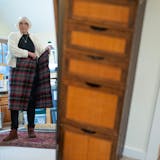Ah, where to start? Maybe (given the bloody fish head in the goblet) by noting that rogue taxidermists are fervent animal lovers. "As humans, we so rarely get to interact with animals on such an intimate level unless they're dead," said artist Scott Bibus. "You have to come to the work with a huge amount of respect."
Or maybe (given the winged monkey wielding a martini glass) by noting that whimsy and reverence can coexist. Sarina Brewer took comfort as a child in the concept of reincarnation, "knowing the animals weren't really entirely gone — they would live on in another form."
Or maybe (given that there's a new book, "Taxidermy Art: A Rogue's Guide to the Work, the Culture and How to Do It Yourself") by noting that the Minnesota Association of Rogue Taxidermists, or MART, has international cred.
Really?
"Yes. Oh, yes," said Robert Marbury, with an edge of glee in his voice. "Everyone doing this around the world wants to be in the Minnesota chapter. That's why it's still the only chapter."
Perhaps best now to explain rogue taxidermy.
Formally, it is "a genre of pop-surrealist art characterized by mixed media sculptures containing conventional taxidermy related materials used in an unconventional manner." Thus, bionic fawns and bedazzled rabbits. Chicks suspended from tiny balloons. Ferrets detailed with gold leaf.
Marbury, the author of "Taxidermy Art" (Artisan, $18.95), is a founder with Brewer and Bibus of MART. Ten years ago, the trio's artistic orbits intersected in the warehouses of northeast Minneapolis.


